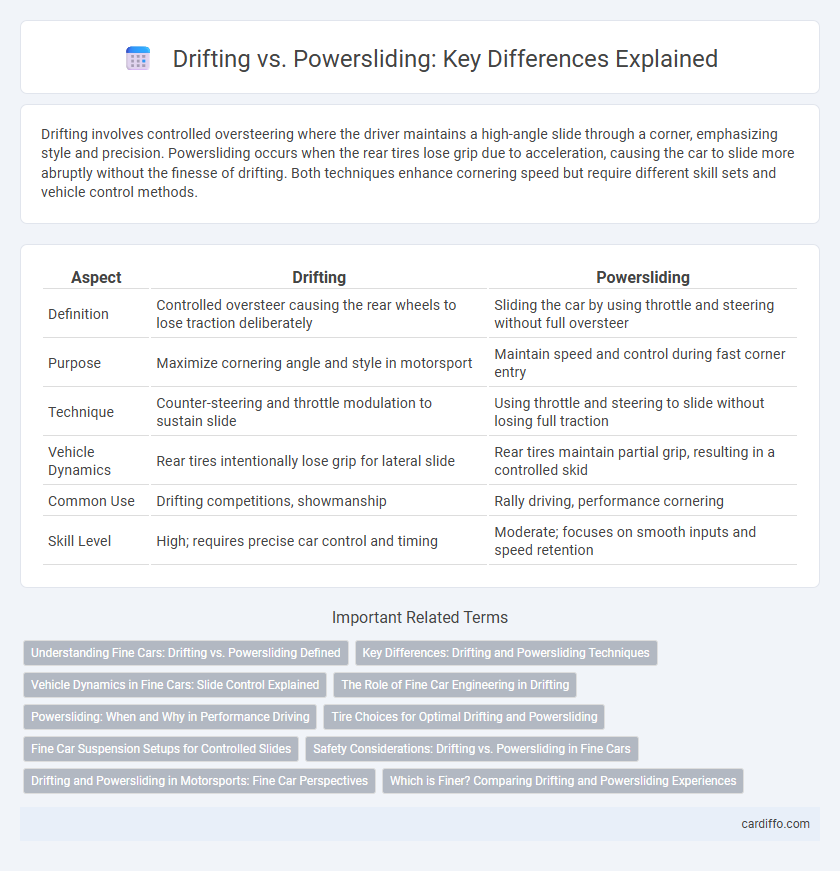Drifting involves controlled oversteering where the driver maintains a high-angle slide through a corner, emphasizing style and precision. Powersliding occurs when the rear tires lose grip due to acceleration, causing the car to slide more abruptly without the finesse of drifting. Both techniques enhance cornering speed but require different skill sets and vehicle control methods.
Table of Comparison
| Aspect | Drifting | Powersliding |
|---|---|---|
| Definition | Controlled oversteer causing the rear wheels to lose traction deliberately | Sliding the car by using throttle and steering without full oversteer |
| Purpose | Maximize cornering angle and style in motorsport | Maintain speed and control during fast corner entry |
| Technique | Counter-steering and throttle modulation to sustain slide | Using throttle and steering to slide without losing full traction |
| Vehicle Dynamics | Rear tires intentionally lose grip for lateral slide | Rear tires maintain partial grip, resulting in a controlled skid |
| Common Use | Drifting competitions, showmanship | Rally driving, performance cornering |
| Skill Level | High; requires precise car control and timing | Moderate; focuses on smooth inputs and speed retention |
Understanding Fine Cars: Drifting vs. Powersliding Defined
Drifting involves intentionally oversteering to cause a controlled loss of traction in the rear wheels while maintaining high speed through corners, emphasizing precision and style. Powersliding, commonly used in rally racing, refers to inducing a slide by applying throttle and steering simultaneously to navigate tight bends efficiently. Both techniques require advanced car control but differ in their approach to balance, throttle application, and intended vehicle dynamics.
Key Differences: Drifting and Powersliding Techniques
Drifting involves intentionally oversteering and controlling a vehicle's rear wheel slip to maintain a high-speed, controlled slide through corners, primarily using throttle and countersteering techniques. Powersliding occurs when the driven wheels lose traction due to sudden throttle application, causing the car to slide without the nuanced control required in drifting. Key differences lie in the driver's input precision and vehicle control, with drifting emphasizing sustained, smooth slides and powersliding representing a more abrupt loss of grip.
Vehicle Dynamics in Fine Cars: Slide Control Explained
Drifting and powersliding in fine cars showcase distinct vehicle dynamics where drifting involves intentional oversteer with sustained rear-wheel slip, enabling controlled over-rotation around corners. Powersliding relies on balanced throttle input and steering to induce a controlled slide without full loss of grip, emphasizing lateral traction management. Slide control systems in high-performance vehicles optimize traction and stability by dynamically adjusting torque distribution and braking to maintain smooth cornering and prevent spinouts.
The Role of Fine Car Engineering in Drifting
Fine car engineering plays a critical role in drifting by optimizing suspension geometry, differential settings, and weight distribution to enhance control and responsiveness during high-speed slides. Precision tuning of the chassis and hydraulic handbrakes allows drivers to initiate and maintain drifts with stability and predictability. Advanced materials and aerodynamic adjustments further improve tire grip and reduce body roll, enabling smoother transitions and sustained powerslides on various track conditions.
Powersliding: When and Why in Performance Driving
Powersliding is utilized in performance driving to maintain higher control and stability during cornering by intentionally oversteering while managing throttle input to balance the car's traction. It is especially effective on low-grip surfaces or tight corners where maintaining momentum and reducing lap times are crucial. Powersliding allows drivers to navigate turns faster without losing as much speed compared to traditional drifting, improving overall track performance.
Tire Choices for Optimal Drifting and Powersliding
Selecting the right tires is crucial for optimal drifting and powersliding performance, with softer compound tires providing increased grip for controlled slides, while harder compounds enable easier slide initiation and longer tire life. Drift-specific tires often feature reinforced sidewalls to withstand lateral forces and high temperatures generated during extended slides. Balancing tire tread pattern and compound stiffness helps drivers maintain optimal traction and slide control on various surfaces, enhancing overall maneuverability and precision.
Fine Car Suspension Setups for Controlled Slides
Fine car suspension setups for controlled slides require precise tuning of stiffness and damping to balance grip and slip during drifting or powersliding. Adjusting camber angles and ride height improves tire contact patches, enhancing stability and responsiveness in transitions. Optimal suspension geometry tailored to vehicle dynamics maximizes control, allowing drivers to maintain smooth, consistent slides without losing traction.
Safety Considerations: Drifting vs. Powersliding in Fine Cars
Drifting in fine cars requires precise control and often involves higher speeds, increasing the risk of tire wear and vehicle damage, thus demanding advanced safety measures like reinforced suspension and high-performance tires. Powersliding, while also challenging, typically occurs at lower speeds with less aggressive vehicle dynamics, reducing the likelihood of mechanical failure and enhancing overall safety. Proper driver training and the use of safety equipment such as helmets and roll cages are crucial in both techniques to minimize accidents and injuries.
Drifting and Powersliding in Motorsports: Fine Car Perspectives
Drifting in motorsports involves controlled oversteer, where the driver intentionally induces and maintains a slide to navigate corners with precision and style, showcasing vehicle balance and throttle control. Powersliding, often used in rally and off-road racing, emphasizes a more aggressive slide initiated through throttle and steering inputs to maintain speed on loose surfaces. Fine car perspectives highlight how drifting demands refined chassis tuning and tire selection for optimal grip modulation, while powersliding prioritizes torque management and suspension setup to maximize traction and agility.
Which is Finer? Comparing Drifting and Powersliding Experiences
Drifting offers a smoother, more controlled slide with an emphasis on maintaining a car's angle through precise throttle, brake, and steering inputs, creating a stylish and dynamic driving experience. Powersliding, by contrast, involves intentionally breaking rear traction for a less refined, more aggressive slide, often used to quickly navigate tight corners or correct vehicle direction. For purists seeking finesse and skill expression, drifting is finer due to its balance of control and aesthetics, while powersliding suits those prioritizing immediate vehicle response and raw power.
Drifting vs Powersliding Infographic

 cardiffo.com
cardiffo.com